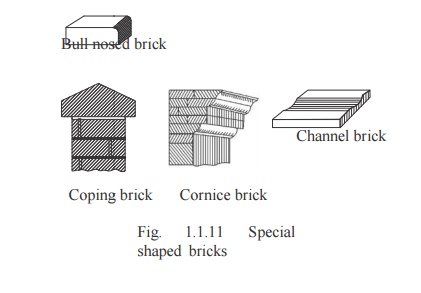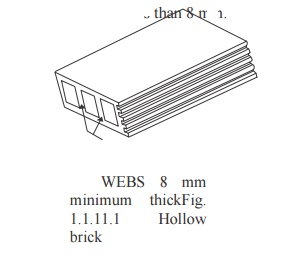Chapter: Civil Engineering : Surveying and Civil Engineering Materials
Bricks
Bricks
1 Properties of Bricks
2 Tests on Bricks
3 Classification of Bricks Based on their Quality
4 Uses of Bricks
Bricks
Brick is obtained by moulding good clay into a
block, which is dried and then burnt. This is the oldest building block to
replace stone. Manufacture of brick started with hand moulding, sun drying and
burning in clamps. A considerable amount of technological development has taken
place with better Knowledge about to properties of raw materials, better
machineries and improved techniques of moulding drying and burning.
The size of the bricks are of 90 mm
× 90 mm × 90 mm and 190 mm × 90 mm × 40 mm. With mortar joints, the size of
these bricks are taken as 200 mm × 100 mm × 100 mm and 200 mm × 100 mm
(i) Building Bricks: These bricks are used for the construction of walls.
(ii) Paving Bricks: These are vitrified bricks and are used as pavers.
(iii) Fire Bricks: These bricks are specially made to withstand furnace
temperature. Silica bricks belong to this category.
(iv) Special Bricks: These bricks are different from the commonly used building bricks
with respect to their shape and the purpose for which they are made. Some of
such bricks are listed below:
(a) Specially shaped bricks
(b) Facing bricks
(c)Perforated building bricks
(d) Burnt clay hollow bricks
(e) Sewer bricks
( f ) Acid resistant bricks
(a) Specially
Shaped Bricks: Bricks of special shapes are
manufactured to meet the requirements of different situations. Some of
them are shown in Fig. 1.1.11.

(b) Facing
Bricks: These bri cks are used in the outer
face of masonry. Once these bricks are provided, plastering is not
required. The standard size of these bricks is 190 × 90 × 90 mm or 190 × 90 ×
40 mm.
(c) Perforated Building Bric
ks: These bricks are manufactured with area of perforation of
30 to 45 per cent.
The area of each perforation should not exceed 500 mm2. T he
perforation should be uniformly distribute d over the surface.
They are manufactured in the size 190× 190 × 90
mm and 290 × 90 × 90 mm
(d) Burn’t Clay Hollow Brick s: Figure 1.1.11.1 shows a burnt clay
hollow b rick. They are light in weight. They are used for the
construction of partition walls. They provide good thermal insulation to buildi
ngs. They are manufactured in the sizes 190 × 190 × 90 mm,290 × 90 × 90 mm and
290 × 140 × 90 mm. The thickness of any shell should not be less than 11 mm and
that of anny web not less than 8 mm.

WEBS 8
mm minimum thick
Fig. 1.1.11.1 Hollow brick
(e) Sewer
Bricks: These bricks are used for the
construction of sewage li nes. They are manufactured from surface cl ay,
fire clay shale or with the combination of th ese. They are manufactured in the
sizes 190 × 90 × 90 mm and 190 × 90 × 40 mm. The av erage strength of these
bricks should be a m inimum of 17.5 N/mm2 . The water absorption
should not be more than 10 per cent.
( f ) Acid
Resistant Bricks: These bricks are used for
floorings likely to be subjected to acid attacks, lining of chambers in
chemical plants, lining of sewers carrying industrial wastes etc. These bricks
are made of clay or shale of suitable composition with low lime and iron
content, flint or sand and vitrified at high temperature in a ceramic kiln.
Properties o
f Bricks
The following are the required
properties of good Bricks:(i) Colour: Colour should be uniform
and bright.
(ii) Shape: Bricks should have plane faces. They should have sharp and true
right angled corners.
(iii) Size: Bricks should be of standard sizes as prescribed by codes.(iv)
Texture: They should possess fine, dense and uniform texture. They
should not possess fissures, cavities, loose grit and unburnt lime.
(v)
Soundness: When struck with hammer or with
another brick, it should produce metallic
sound.
(vi) Hardness: Finger scratching should not produce any impression on the
brick.
(vii)
Strength: Crushing strength of brick should not be less
than 3.5 N/mm2. A field test for strength is that when
dropped from a height of 0.9 m to 1.0 mm on a hard ground, the brick should not
break into pieces.
(viii) Water
Absorption: After immercing the brick in water
for 24 hours, water absorption should not be more than 20 per cent by
weight. For class-I works this limit is 15 per cent.
(ix)
Efflorescence: Bricks should not show white
patches when soaked in water for 24 hours and then allowed to dry in
shade. White patches are due to the presence of sulphate of calcium, magnesium
and potassium. They keep the masonry permanently in damp and wet conditions.
(x) Thermal Conductivity: Bricks should have low thermal conductivity, so that buildings
built with them are cool in summer and warm in winter.
(xi) Sound Insulation: Heavier bricks are poor insulators of sound while light weight
and hollow bricks provide good sound insulation.
(xii) Fire Resistance: Fire resistance of bricks is usually good. In fact bricks are
used to encase steel columns to protect them from fire
Tests on Bricks
The following laboratory
tests may be conducted on the bricks to find their suitability:
(i) Crushing strength
(ii) Absorption
(iii) Shape and size
and
(iv) Efflorescence.
(i)
Crushing Strength: The brick specimen are immersed in water
for 24 hours. The frog of the brick is filled flush with 1:3 cement mortar and
the specimen is stored in damp jute bag for 24 hours and then immersed in clean
water for 24 hours. The specimen is placed in compression
testing machine with 6 mm plywood on top
and bottom of it to get uniform
load on the
specimen. Then load is applied axially at a uniform rate of 14 N/mm2
. The crushing load is noted. Then the crushing strength is the ratio of
crushing load to the area of brick loaded. Average of five specimen is taken as
the crushing strength.
(ii) Absorption Test: Brick specimen are weighed dry. Then they are immersed in water
for a period of 24 hours. The specimen are taken out and wiped with cloth.
The weight of each specimen in wet
condition is determined. The difference in weight indicate the water absorbed.
Then the percentage absorption is the ratio of water absorbed to dry weight
multiplied by 100. The average of five specimen is taken. This value should not
exceed 20 per cent.
iii) Shape and Size: Bricks should be of
standard size and edges should be truely rectangular with sharp
edges. To check it, 20 bricks are selected at random and they are stacked along
the length, along the width and then along the height. For the standard bricks
of size 190 mm × 90 mm × 90 mm. IS code permits the following limits:
|
Lengthwise: |
3680 |
to |
3920mm |
|
Widthwise: |
1740 |
to |
1860mm |
|
Heightwise: |
1740 |
to |
1860mm |
The following field
tests help in acertaining the good quality bricks:
(i)
uniformity in size (ii) uniformity in colour
(iii) structure
(iv) hardness test
(v) sound test
(vi) strength test.
(i) Uniformity in Size:
A good brick should have rectangular plane surface and uniform
in size. This check is made in the field by observation.
(ii) Uniformity in Colour:
A good brick will be having uniform colour throughout. This
observation may be made before purchasing the brick.
(iii) Structure: A few bricks may be broken in the field and their cross-section
observed. The section should be homogeneous, compact and free from defects
such as holes and lumps.
(iv) Sound Test: If two bricks are struck with each other they should produce
clear ringing sound. The sound should not be dull.
(v) Hardness Test:
For this a simple field test is scratch the brick with nail. If no impression
is marked on the surface, the brick is sufficiently hard
(vi) Efflorescense: The presence
of alkalies in brick is not desirable because they form patches of gray
powder by absorbing moisture. Hence to determine the presence of alkalies this
test is performed as explained below:
Place the brick specimen in a glass
dish containing water to a depth of 25 mm in a well ventilated room. After all
the water is absorbed or evaporated again add water for a
depth of 25 mm. After second evaporation observe
the bricks for white/grey patches. The observation is reported as ‘nil’, ‘slight ‘moderate’, ‘heavy’ or serious
to mean
(a) Nil: No patches
(b) Slight: 10% of area covered with deposits
(c) Moderate: 10 to 50% area
covered with deposit but unaccompanied by flaking of the surface. (d)
Heavy: More than 50 per cent area covered with deposits but unaccompanied by
flaking the surface.
(e) Serious: Heavy deposits of salt accompanied by
flaking of the surface.
Classification of Bricks Based on their Quality
The bricks used in construction are
classified as:
(i) First class bricks (ii)
Second class bricks
(iii) Third class bricks and
(iv) Fourth class bricks
(i) First Class Bricks: These bricks are of standard shape and size. They are burnt in
kilns. They fulfill all desirable properties of bricks.
(ii) Second Class Bricks: These bricks are ground moulded and burnt in kilns. The edges
may not be sharp and uniform. The surface may be some what rough. Such
bricks are commonly used for the construction of walls which are going to be
plastered.
(iii) Third Class Bricks: These
bricks are ground moulded and burnt in clamps. Their edges are somewhat
distorted. They produce dull sound when struck together. They are used for
temporary and unimportant structures.
(iv) Fourth Class Bricks: These are the over burnt bricks. They are dark in
colour. The shape is irregular. They are used as aggregates for concrete
in foundations, floors and roads.
Uses of Bricks
Bricks are used in the following
civil works:
(i) As building blocks.
(ii) For lining of ovens, furnaces and
chimneys. (iii) For protecting steel columns from fire.
(iv) As aggregates in providing water
proofing to R.C.C. roofs. (v) For pavers for footpaths and cycle tracks.
(vi) For lining sewer lines.
Related Topics